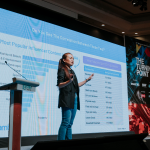A Quiet Revolution and Its Unanticipated Benefactors
Think about this: When refrigeration technology was first introduced, it was not the manufacturers who reaped the greatest rewards. Instead, soda titans like Coke and Pepsi emerged the unexpected beneficiaries. Fastforward to the mobile revolution, history repeated itself – withs device trailblazers like Apple and internet powerhouses like Google and Meta who profited the most, and not the chip companies.
Fast forward to the AI revolution, it is clear that we are looking at a similar pattern. While AI pioneers like Nvidia are reaping immediate rewards, the ultimate winners will be the businesses that seamlessly integrate AI into their workflow, so covertly that the consumers do not even realize it.
For CEOs, AI is evidently becoming a potent tool to supercharge operations, supply chains, and financial management. But for marketers, the AI story is taking an exciting turn. AI is not just helping them elevate campaigns, streamline budgets, and manage resources more effectively, but it’s also becoming a crucial part of the marketing process itself.
It is no longer just about using AI applications like ChatGPT and MidJourney to generate content. The game-changer is when marketers are able to weave AI into their entire marketing DNA.

The Shift from Marketer-Controlled to AI-Controlled Campaigns
Technological advancements in AI have led ad platforms to assume greater control, translating to minimum inputs from marketers. In fact, tech giants like Google, Meta, and other platforms enhance their ad products using AI. This has automated the entire ideation and end-result process with only a few minutes spent on the keyboard to input the budget, objectives (awareness or sales) as well as the creatives.
These enhancements have also democratized the campaign execution process; ultimately allowing anyone with limited knowledge to start spending on ad campaigns on Facebook or Google. With humans providing fewer inputs, algorithms have a lot of constant attributes providing room to learn from the data faster and predict better results to optimize spending and manpower.
A perfect example would be Google’s Performance Max or Meta’s Advantage+, both amazing product enhancements; sending the right behavior data to the campaigns and that make fewer changes giving them the best results despite the lesser control. You cannot blame these companies for taking away control; at the end of the day, they are in the business of serving the most interesting content and ads to consumers.

Marketers working for AI to AI working for marketers
If you think about it, in the digital space, all marketing functions do is to align their work to impress algorithms of either ad platforms or social platforms.
- Performance marketers optimize the campaign to help the algorithm show the ad to the right audience.
- Social media strategists are developing posts with trending audio or events so that the algorithm catches; they must know what content the algorithm constantly prioritizes.
- An SEO person optimizes the page so that the algorithm ranks higher in the search results.
- The copywriter, content writer, and graphic designer are on the same track of aligning their work to the algorithm.
With these new LLMs (Large Language Models) and Generative AI at marketers’ disposal, they can generate content (Text, video, images) faster, increasing the probability of getting more success with algorithms and with consumers.
Because of this, the AI-driven landscape now demands a reimagined role for CMOs. Before diving into their own departments, CMOs need to collaborate across the board to effectively harness AI.
Most successful CMOs of digital-first companies have something in common; they maintain a very good relationship with their technology counterparts. More often than not, marketing requests are often deprioritized in the tech world’s bug-fixing, feature-rolling, and regulator’s request compliance rush.
Successful CMOs are those who are able to prove the value of their requests to the business, ultimately making it to the priority list. Marketing should work with the tech teams to ensure the right behavior data is passed to the marketing platforms.
They must build relationships with product teams so they get a say in the product development roadmap, and collaborate with data teams who take the valuable data from marketing and apply it for business, to the business.
Building a brand is and cannot be a solo act. The branding team alone cannot build the brand; it is everyone’s responsibility and that includes product, tech, data and customer experience (CX) functions.
Within the marketing department, it is mostly cultural change. CMOs have to lead by example by getting their hands dirty and showing the value of AI tools as allies and not threats.
Eliminate any fear of AI taking the team’s jobs because nearly every marketing function is positively impacted by the tools of AI.
The idea is to build and scale the team’s capabilities using AI, advancing their roles and outcomes of campaigns. Here are a few examples.
- MidJouney, stable diffusion is making it easier for the creative teams to build mood boards and concepts.
- Generative AI in Adobe Photoshop is opening new creative opportunities for designers with just prompts.
- Plugins of ChatGPT that accept PDFs improve research speed for brand strategists.
- Plugins of Chat GPT that accept CSV can analyze your performance campaign data saving hours on Excel.
- AI-based editing tools repurpose videos and images, packaging them to distribute on social platforms.
AI at CARSOME
As a tech company, CARSOME is ahead of the game, using AI in product listing, pricing, logistics, and car inspections. The marketing team has been experimenting with multiple tools and vendors to improve efficiency, however, not everything has given us our desired results.
Eventually, we shifted from manual budget allocation to an AI-driven approach. We have included creatives generated using AI while tools like MidJourney, Dalle-2, and stable diffusion have added a fresh, fun element to our ideation process.
The outcome? – a significant reduction in our Customer Acquisition Cost (CAC).
This article is attributed to Ravi Shankar Mallavarapu, Chief Marketing Officer
MARKETING Magazine is not responsible for the content of external sites.











